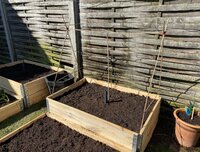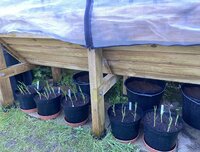Back down on the Rea Farm... There’s only so much ‘PE with Joe’ YouTube lessons you can do with your kids before you start feeling your age

More brain exercise, less physical torture today...
So as this lock in continues have been seeing what principles from aquatic plant care apply to horticulture. Charles Dowding’s advocation of the ‘no dig’ method makes a lot of sense to a certain extent, at least to me. Particularly interested in the comparison of the strata you can view in aquarium soil as the months pass by, various zones become ideal for bacterium of countless varieties, and that of the soil in the vegetable beds being left to settle in the same manner - effectively no digging/tilling the soil between crop.
The taller beds have had a deep vertical channel dug beneath them before being setup. This top soil, broken up clay where the rose bush/pontentilla bush rooted downwards and the compacted clay down to the hardcore from the building site rubble, has been lifted out and redistributed throughout the compost. I suppose the idea is to seed the beds with whatever survives from the upheaval and let it settle for a month before planting. I won’t disturb it beyond this for at least five years now.
The veg trug over the last five years has been run this way, only adding manure to the surface in late autumn to rot down over winter, but never disturbing the soil. With successive years it’s become less prone to weeds and yield has been great. Managed to negate disease/pathogens ruining crop, but this may just be luck and a suspended bed is not the same as a raised bed as a caveat.


Watering these taller beds will be done a foot down. I’ll be multi-cropping these beds to a) get the most out of them and b) to provide weed suppression. Also deeper watering extends the number of species that can be implemented in the beds. For example, one bed will have tomato plants central, basil near the root system of the toms and onions around the perimeter. The top 6” of dryer soil will be ideal for the basil and onions whilst catering to the consistent watering needed for the toms.


Beyond that just getting ready to plant out mixed lettuce under cover next week as the night time temps become more forgiving.


The hope is to get the AS1200 back after all this propagation and scape that sucker in the summer. Then we can use all that water from rampant water changes in the first month to water the crops.














